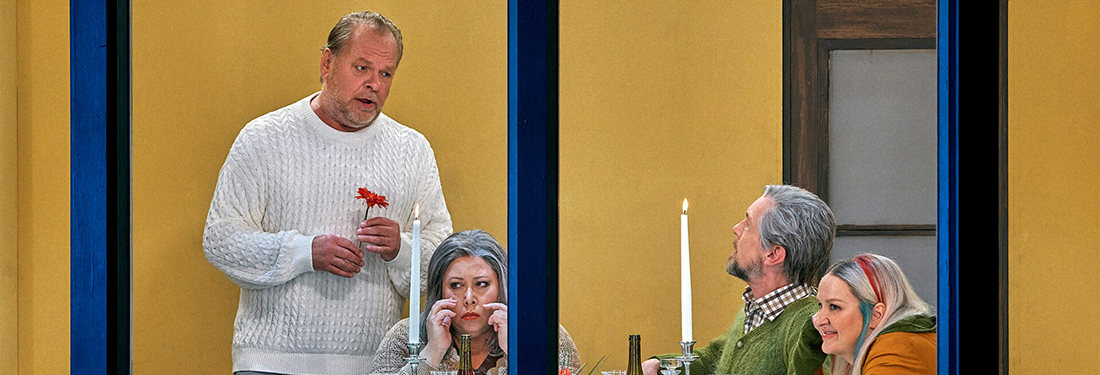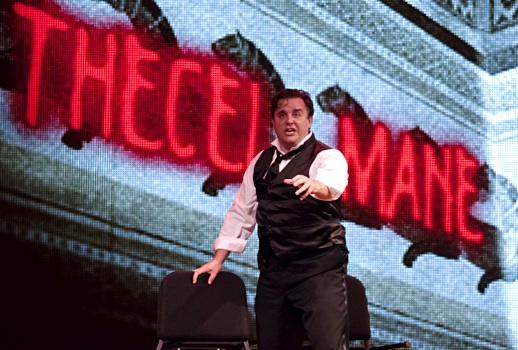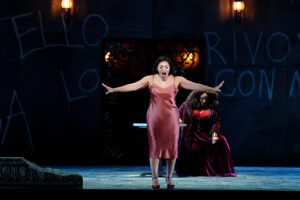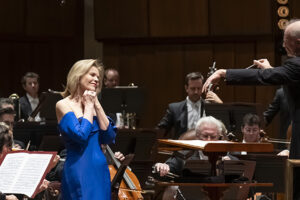

The kingdom of Italy was abolished the next year, its king, Napoleon, banished to Elba. Rossini did rather better: Il barbiere di Siviglia (to the annoyance of old Paisiello, whose greatest hit was a work of the same name) appeared in 1816, and Rossini was a made man; every other composer hoping for success in Italy was obliged to imitate his style.
Thirteen years later, having composed Guillaume Tell, a far larger and more complex work than anything he’d done so far, the composer, depressed and overworked, quarreling with his wife and with the French government, retired from the composer’s chair, though as an impresario, a founder of conservatories, a mentor and advisor and dabbler, he remained a noteworthy presence for 30 years more.
Some artists know who they are from the first. It is exciting and very Hollywood to watch a composer slowly emerge from promising but not too promising beginnings—it gives us the comfortable feeling that we are wiser than contemporary critics. But Rossini, only in his teens, already understood his gift and how to apply it.
Ciro in Babilonia, composed in 1812 in Ferrara, and given its American premiere last Saturday at the Bel Canto at Caramoor program, is unusual in being derived loosely from the Old Testament, the preferred source for works given at the Lenten season. The O.T. was considered less frivolous than, say, classical myth or Ariosto or Walter Scott, sources of the annual Carnival commissions. (The New Testament was quite out of bounds on the secular stage, but saints’ lives could serve as subjects for oratorios.)
A difficulty arose because the most exciting Biblical incidents—in this case the Writing on the Wall at Belshazzar’s Feast—are quite briefly described in the Bible. (Strauss’s Salome encounters a similar problem.) There isn’t much in the way or melodious dispute, never mind the sex dilemmas basic to opera. Librettists got around this by inventing characters, subplots, invocations.
The resemblance of Ciro in Babilonia to, say, Handel’s Rodelinda is not so much coincidental as generic. Belshazzar becomes a generic villain, ergo one who lusts for his neighbor’s wife, while Cyrus the Great becomes a generic hero and not the highly original figure of history, creator of the world’s first enduring multinational empire. The music for any of these characters could be, and was, moved to other operas, being far more personal to the singers than to the story.
The overture to Ciro had been composed for L’Inganno felice. The climactic trio for Ciro, Baldassare and Amira (the hypotenuse of their triangle) turned up in Elisabetta, Regina d’Inghilterra. The concerted finale to the first act, with murder and massacre threatened and deplored, could easily have come from one of Rossini’s sparkling farces. Ciro does not add a great deal to what we already know of Rossini’s talent; its tale of sacrilege and divine justice is as melodious and merry as any comedy, and therefore it enjoyed a certain peninsular popularity at the proper time of year. The choric gravitas of Mosè in Egitto is not to be found here, though that was written a mere six years later.
Ewa Podles, who sang Cyrus, is a renowned Rossini specialist with one of the most curious voices of the last generation or two, a plummy sound, sexy without distinctly representing either gender, passionate and passionately deployed. Hers is such an idiosyncratic, uneven sound that she has turned off almost as many people as she has thrilled.
Thrill is the word, though: She doesn’t always produce the right sound or the easy one, but she never makes a bland one. Impresarios who like to be able to pigeonhole a singer have not cared for her—or that’s how I interpret the Met’s disdain after her spectacular debut there as Handel’s Rinaldo in 1984. She was covering Marilyn Horne, and the Met didn’t feel it needed another Marilyn Horne.
Podle? is now 60 years old, but her instrument seems in no way inferior to that with which she sang Rossini’s Tancredi in Boston a couple of years back. She takes time to warm up—in the first part of the evening, her best tones were confined to a single octave beyond which pitch and support problems emerged. After the interval, though, her range and power grew.
A duet with Jessica Pratt’s Amira was sheer heaven, similar in character to the Horne-Sutherland duetting of yore, with very different but equally lovely voices. The all but endless double-aria for Ciro which concludes the opera gave us another Podles, the agonized but triumphant philosopher-king whose occasional scattershot top notes were played for dramatic punch. She is a great theatrical figure and knows how to use her weaknesses to effect.

I’d never heard the role of Baldassare, of course, but it seemed that two different tenors were performing it: The high, sweet one familiar from Spyres’ previous outtings and, at other moments, a much lower, grittier voice, almost baritonal, as agile as his upper voice and always interesting but not seductive. Was the part written for a tenor of unusually broad range, or did Spyres lower his timbre (and some of the top notes) in order to manage it with an instrument that is still evolving? His acting of the arrogant monarch was dignified and effective, and everything he sang was of interest. The performance was not puzzling; the direction of the career, to this admirer, may be.
British soprano Pratt, who has been singing leading coloratura roles around Europe, made (I think) her American debut as Amira, Ciro’s wife, Baldassare’s captive and latest obsession. Tall, blonde and handsome, Pratt has quite a reputation but I do not find her a finished product. As on several of her recordings, there were wonderful, melting phrases and off-pitch shrieks, elegant ornaments here, fake trills there, adorable harmonies and wince-inducing cries.

Scott Bearden made an imposing Assyrian courtier, Sharin Apostolou was able if not exceptional as Amira’s confidante, Krassen Karagiozov pleasant as the literate prophet Daniel (surely his explication would be more effective sung by a darker timbre?) and Eric Barry was as incompetent a tenor as he proved a plotter.
Will Crutchfield, founder and leader of the bel canto series at Caramoor, led the St. Luke’s Chamber Orchestra in a performance full of melodious charm, with several extraordinary moments in preludes and ritornellos, as well as vigorous accompaniment of the singers. One could wish that his programs would introduce us to less familiar composers of this era, such as Vaccai (Giulietta e Romeo), Mercadante (Virginia; Il Bravo), Pacini (Medea; Carlo di Borgogna), Carafa (Gabriella di Vergy) or Ricci (Luigi Rolla), rather than yet another half-familiar Rossini obscurity, intriguing as it is to behold the ever widening picture. Does he doubt that his loyal Caramoor audience would follow him into such obscure thickets? I believe the varied fare would prove up to standard.
The production of Ciro was more or less staged, a co-production with the annual Rossini Festival in the composer’s birthplace, Pesaro. In practice, this meant great screens were introduced as backdrops (cheaper than painted flats, eh?), and a director, Davide Livermore, and a video designer, Paolo Cucco, had their wicked way with Ciro. Mr. Cucco appears to be one of those designers who cannot believe that music is an activity and therefore accompanies every sound with some visual distraction; this may be necessary for hip-hop videos, it is tedious when the vocalism is appealing in itself.

On the whole I was glad to do largely without supertitles for a basic and repetitive libretto. But since titles were rare, shouldn’t a synopsis have been included in the program? No one knew this opera and not everyone reads the Bible any more. I was tipped off because almost my first operatic experience was the twelfth-century Play of Daniel, televised from the Cloisters by the New York Pro Musica Antiqua back when Channel 13 was black-and-white only. Same story! Excellent music! Far better sets and direction!
Photos: Gabe Palacio
























Comments